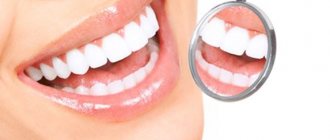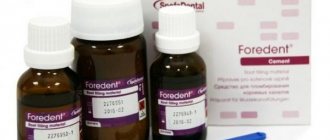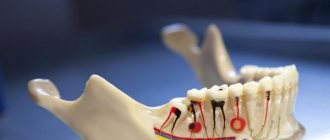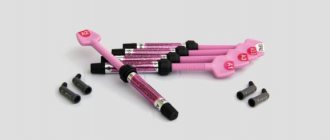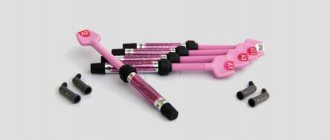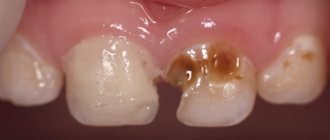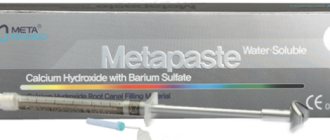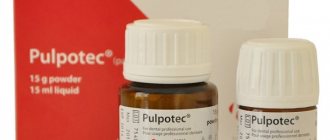Apexdent is a filling adhesive paste that fills tooth canals. It is an X-ray contrast material that is used to seal inflamed and infected difficult-to-pass areas of the canal.
Apexdent is produced in the form of a homogeneous paste with calcium hydroxide, which can be with or without iodoform.
Modern material has been approved by many leading experts.
Release form and composition
Apexdent without iodoform contains:
- calcium hydroxide for dental tissue regeneration;
- calcium phosphate, which actively stimulates the formation of osteoblasts, is intended for the mineralization of dental bone tissue;
- X-ray contrast filler;
- a paste agent that makes it easy to fill small cavities.
Apexdent with iodoform contains 40% of this substance, which ensures a long-term antibacterial effect and prevents re-infection of the tooth.
The filling material is produced in the form of a homogeneous paste, completely ready for use. Packaged in syringes of 2 g. The kit may include special curved needles (5 pcs.).
This material belongs to the long-hardening type. Certified and complies with GOST R 51059-97. Produced by VladMiVa (Russia).
Features of the treatment of pulpitis on teeth with unformed roots
Treatment of pulpitis on such teeth has its own characteristics. Due to the fact that it is impossible to completely treat the entire length of the tooth roots and extract the pulp, traditional devital and vital methods for treating teeth with immature roots are not suitable. Therefore, pediatric dentists use biological treatment methods or the amputation method.
Conservative treatment
It should be noted that biological (conservative) treatment is a rather complex process that has a number of contraindications. The main principle of treatment is maintaining absolute sterility. It is very important to carry out high-quality antiseptic and aseptic processing.
During the biological treatment of pulpitis, the dentist, under anesthesia, removes not only plaque, but also all affected and dead dental tissue, prepares the tooth cavity and applies medicine to the exposed nerve (or to the bottom of the carious cavity). As a rule, this medicinal paste contains calcium hydroxide. After all pain symptoms disappear after a few days, a permanent filling can be installed. The main thing is that as a result of this treatment, the tooth retains its vitality and strength, and the pulp provides nutrients to its tissue.
Amputation method for treating teeth with immature roots
Due to the complexity of biological treatment and the existing contraindications to this method, this method is used infrequently by dentists. And most doctors prefer amputation, during which the doctor removes the infected pulp from the pulp chamber using a vital or non-vital method.
- The devital method using arsenic compounds is not used in every clinic today. Some dental offices use phenol-formalin to necrotize the pulp. To do this, a swab moistened with this solution is applied to the tooth cavity for 4-5 days.
- Most often, pediatric dentists treat pulpitis using the vital method, without the use of arsenic. To do this, doctors use not only local anesthesia, but also various antibacterial drugs, calcium-containing drugs and remineralizing agents. During this method, the pediatric dentist, after taking care of anesthesia, excises the upper part of the pulp and applies a special preparation. Thanks to this method, it is possible to preserve the root pulp, which means that in the future the dental roots will continue their normal formation.
Alternative
Prevention of pulpitis is careful adherence to hygiene rules. Use Asepta toothpastes, which effectively strengthen tooth enamel and prevent the growth of bacteria in the oral cavity.
Basic properties
Due to its high pH level (˃12), calcium hydroxide has a long-lasting antiseptic effect. The use of Apexdent promotes:
- long-term bactericidal effect on inflamed dental tissues and the periapical area;
- creating a strong dentinal barrier and creating conditions for the formation of a tooth root (within 3 – 6 months the apical root hole is formed);
- restoration of hard dental tissues.
After using dental paste with iodoform for chronic periodontitis, within the next 6 to 14 months it becomes possible to finally fill the canals.
If the filling paste was carried beyond the apex during operation, it gradually dissolves. The patient will not experience pain or discomfort.
Properties
The dental material Apexdent without iodoform is available in the form of a ready-to-use radiopaque paste.
The calcium hydroxide contained in the composition creates a high pH level (12.5). provides a stable, long-lasting bactericidal effect on the remaining dental pulp and/or system of macro- and microcanals, as well as in the periapecal area, leads to the formation of a deitin-cement barrier, creating conditions for the growth and formation of the tooth root, restoration of bone and periapecal tissue.
As a result of the use of dental material Apexdent based on calcium hydroxide, root growth is completed or an apical bone-cement barrier is formed within 9-15 months.
It is possible to use the material in the treatment of canals with an unformed apex of temporary teeth due to periodontitis.
With the conservative treatment of chronic periodontitis, as well as any root perforations, after using Apexdent paste with calcium hydroxide for 3-6 weeks, final filling of the root canal becomes possible.
Attention! Prolonged contact of the material with air should be avoided, as Carbon dioxide in the air reduces the activity of calcium hydroxide.
Scope of application
Apexdent is suitable for the treatment of pulpless teeth (where the nerve has been removed). Paste without iodoform is prescribed for:
- apexification of the tooth (the process of formation of the apex of the dental root), when the process of root growth is not completed;
- closing the wide opening of the apex;
- treatment of pulpitis (inflammation of dental tissues, nerve);
- treatment of chronic periodontitis of molars in which the roots are formed;
- filling canals (difficult to pass) after pulp removal.
A paste containing iodoform is used for similar processes occurring in diseased dental tissues.
The specific difference is that it is more often prescribed for the treatment of infected canals. Indicated for chronic periodontitis.
Iodoform-containing paste is also widely used for filling dental canals. The product is used for:
- treatment of chronic inflammation of the tooth shell;
- bone resorption (destruction of bone tissue) and perforation of the tooth root;
- infection of dental canals;
- damage to the nerve and surrounding tissues;
- unformed tooth root apex.
The material is used in the periapical (near-apical) zones in combination with gutta-percha pins.
Where is it used?
It is in demand when it is necessary to treat teeth that lack nerves (have been depulped). The product without iodoform is used:
- During apexification of teeth
- Wide apex needs to be closed
- Relieves inflammation of tooth tissues
- Chronic periodontitis
The option with iodoform is used in the same situations, only when treating teeth in those tissues that hurt.
They differ in that they are used when treating infected areas.
Used when filling canals in teeth in the following situations:
- When nerves and nearby tissues are affected
- If the apex of the tooth root is not formed
Mode of application
If the paste (without iodoform) is used in the treatment of periodontitis, the procedure is as follows:
- the product is placed into the prepared and cleaned canal using a canal filler and left for 7 – 10 days;
- isolate with a tampon, place a temporary filling, sealing the tooth;
- within the prescribed period, the paste is removed, the channels are cleaned and washed with a special composition (sodium hypochlorite);
- dried, a new portion of material is introduced (for 1 month).
This procedure is carried out every 3 months, for 6 to 15 months. Three months after the first treatment, an x-ray is taken to evaluate the effect. Then, depending on the results, a permanent filling is placed or therapy is continued.
Treatment of pulpitis with unfinished growth of the root apex of the tooth involves:
- performing pulpotomy with anesthesia;
- rinsing the canals;
- direct coating of treated pulp material;
- compacting the paste with a tampon, installing a temporary filling;
- replacing the drug after 3–4 weeks with a fresh portion;
- X-ray control, repeating the course until the final formation of the root;
- installation of a permanent filling.
When using Apexdent for apexification of a tooth, the following is performed:
- traditional dental canal treatment;
- washing with a special composition without pressure;
- drying and introducing filling paste;
- installation of a temporary filling followed by an x-ray;
- replacement with a new portion (after 3 – 4 weeks).
Approximately 3 months from the start of treatment, the condition of the tooth root is determined. Depending on the results, treatment is continued or the canal is finally closed with a permanent filling.
Apexdent instructions
Material stored or transported at low temperatures must be kept at room temperature for at least 1 hour before use.
For apexogenesis in the treatment of pulpitis with incomplete growth and formation of the root apex of a permanent tooth, under anesthesia, a pulpotomy or subtotal pulpectomy (to the apparently healthy bleeding pulp), hemostasis (sodium hypochlorite solution, EndoZhi N "4, Capramin) is performed, then direct coating of the root pulp with paste, lightly compact with a cotton swab or paper point. The tooth cavity is closed with a temporary but durable filling made of GIC. Under the control of EDI, the paste is changed to a fresh portion after 3-4 weeks and then the paste is changed under the control of radiography and EDI until the growth and formation of the tooth root is completed every 2-3 months. After the formation of the apex of the tooth root, a permanent root canal filling is performed under anesthesia.
For apexification of teeth with incomplete root growth, instrumentation of the root canal is carried out according to the traditional method, not reaching 1-2 mm to the apex of the root canal and avoiding excessive thinning of the dentinal walls of the canal (by 1 ISO instrument size). The canal is washed with sodium hypochlorite solution without creating pressure in the canal. Then Apexdent paste based on calcium hydroxide is injected into the dried canal and filled with a temporary but durable filling material made of glass ionomer cement (Cemion, Akvion). After filling, a control x-ray is required.
After 3-4 weeks, it is advisable to replace the paste in the canal with a fresh portion.
If the material is accidentally removed beyond the apex of the tooth root, no complications arise.
After 3 months after the start of treatment, the condition of the periodontium is determined by X-ray or by probing the apical zone of the canal: if there is no compaction in the apical area, the paste should be re-applied into the canal once every 3 months until the apical barrier is completely formed, in the presence of which the root canal is finally filled using the lateral condensation method .
For the treatment of chronic periodontitis, after a diagnostic study of the morphological characteristics of tooth roots and periapical tissues (x-ray), carry out mechanical and medicinal treatment of the canal using sodium hypochlorite solution and EDTA-based canal expansion preparations for irrigation (EndoZhi No. 2).
After thorough drying, “Apexdent” paste based on calcium hydroxide is injected into the canal using a canal filler for a period of 7-10 days. The paste is isolated with a dry cotton swab and the tooth is sealed with a temporary filling made of glass ionomer cement (“Cemion.” “Akvion”). Temporary filling of root canals with calcium hydroxide in adults leads to a 100% improvement and a reduction in periapical changes in a period of 3 to 5 weeks when changing the paste 2-4 times during this period.
Depending on the results, treatment is continued or the root canal is filled permanently.

